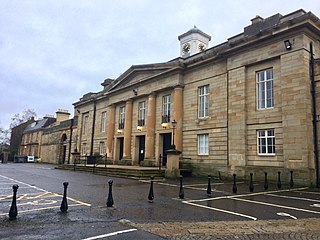
Cheshire is an ancient and ceremonial county in northwest England. It is bordered by the counties of Merseyside and Greater Manchester to the north, Derbyshire to the east, and Staffordshire and Shropshire to the south, while the western boundary consists mostly of the England–Wales border with smaller sections leading into the Irish Sea via Liverpool Bay. Cheshire's county town is the cathedral city of Chester and its most populated town is Warrington, while other towns include Congleton, Crewe, Ellesmere Port, Knutsford, Macclesfield, Nantwich, Runcorn, Widnes, Wilmslow, and Winsford. The county is split into four administrative districts: the Borough of Halton, the Borough of Warrington, Cheshire West and Chester, and Cheshire East.

Knutsford is a market town in Cheshire, England, 14 miles (23 km) south-west of Manchester, 9 miles (14 km) north-west of Macclesfield and 12.5 miles (20 km) south-east of Warrington. The population at the 2011 Census was 13,191.

Macclesfield was, from 1974 to 2009, a local government district with borough status in Cheshire, England. It included the towns of Bollington, Knutsford, Macclesfield and Wilmslow and within its wider area the villages and hamlets of Adlington, Disley, Gawsworth, Kerridge, Pott Shrigley, Poynton, Prestbury, Rainow, Styal, Sutton and Tytherington.

The Inner London Sessions House Crown Court, more commonly known as the Inner London Crown Court and distinct from the Inner London Magistrates' Court, is a Crown Court building in Newington, London, United Kingdom. It is located in the Sessions House on Newington Causeway at the corner of Harper Road. It is a Grade II listed building.

Knutsford railway station serves the town of Knutsford in Cheshire, England. The station is 21+3⁄4 miles (35.0 km) south of Manchester Piccadilly on the Mid-Cheshire Line to Chester. The line is referred to as the Chester via Altrincham line at Manchester Piccadilly, but as the Manchester via Stockport line at Chester station.

St John the Baptist's Church is in the town of Knutsford, Cheshire, England. The church is recorded in the National Heritage List for England as a designated Grade II* listed building. It is an active Anglican parish church in the diocese of Chester, the archdeaconry of Macclesfield and the deanery of Knutsford. Its benefice is combined with that of St John the Evangelist, Toft.

A sessions house in the United Kingdom was historically a courthouse that served as a dedicated court of quarter sessions, where criminal trials were held four times a year on quarter days. Sessions houses were also used for other purposes to do with the administration of justice, for example as a venue for the courts of assize (assizes). The courts of quarter sessions and assize, which did not necessarily sit in dedicated premises, were replaced in England by a permanent Crown Court by the Courts Act 1971, and in 1975 in Scotland by other courts. Several buildings formerly used as sessions houses are still named "Sessions House"; some are still used for the administration of justice, while others have different uses. Some are listed buildings of architectural importance.

The Crown Court at Southwark, commonly but inaccurately called Southwark Crown Court, is a Crown Court venue which deals with criminal cases at 1 English Grounds on the South Bank of the River Thames between London Bridge and Tower Bridge in London. It operates within the South Eastern Region of His Majesty's Courts and Tribunals Service.

The Sessions House is a courthouse in Harris Street, Preston, Lancashire, England. The courthouse, which continues to be used for judicial purposes as well as being used as administrative offices for His Majesty's Courts and Tribunals Service, is a Grade II* listed building.

St John the Evangelist's Church is in Toft Road, Toft, Cheshire, England. It is an active Anglican parish church in the deanery of Knutsford, the archdeaconry of Macclesfield, and the diocese of Chester. Its benefice is combined with that of St John the Baptist, Knutsford. The church is recorded in the National Heritage List for England as a designated Grade II listed building.
There are over 20,000 Grade II* listed buildings in England. This page is a list of these buildings in the unitary authority of Cheshire East.
There are over 9,000 Grade I listed buildings in England. This page is a list of these buildings in the unitary authority of Cheshire East.

St Albans Town Hall, sometimes known as the Old Town Hall or The Courthouse, is a 19th-century building in St Albans, Hertfordshire, England. The building, which now accommodates the St Albans Museum, is a Grade II* listed building.
Knutsford War Memorial Cottage Hospital is a former hospital in Knutsford, Cheshire. It was designed by architect Sir Percy Worthington and opened in 1922.

Gloucester Crown Court is a Crown Court venue which deals with criminal cases at Bearland, Gloucester, England. The court, which is located at the back of Gloucester Shire Hall, is a grade II listed building.
The ceremonial county of Cheshire, which comprises the unitary authorities of Cheshire East, Cheshire West and Chester, Halton and Warrington, has returned 11 MPs to the UK Parliament since 1997.

Stirling Sheriff Court is a judicial building in Viewfield Place, Stirling, Scotland. The building, which remains in use as a courthouse, is a Category B listed building.

The Teesside Combined Court Centre is a Crown Court venue, which deals with criminal cases, as well as a County Court venue, which deals with civil cases, in Corporation Road, Middlesbrough, England.

Durham Crown Court is a Crown Court venue which deals with criminal cases at Old Elvet, Durham, England. Located immediately to the north of Durham Prison, it is a Grade II* listed building.

Shrewsbury Justice Centre is a Crown Court venue which deals with criminal cases, in Preston Street, Shrewsbury, England.
















